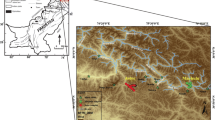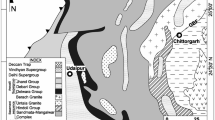Abstract
Laboratory reflectance spectra of 18 rock samples from the Precambrian basement of north east of Hajjah were measured and analyzed using the instrument of FieldSpec3 with spectral range 0.250–2.500 µm. The aim of this study is to use the spectral reflectance of rocks for mapping the mineral resources in the north east of Hajjah. The altered system in the study area comprises of silicification, sericitification, oxidation, clay minerals and carbonatization. Silicified alteration is not distinguishable in the regions of Visible-Near Infrared (VNIR) and Short wave Infrared (SWIR) of the electromagnetic spectrum, because of lack of diagnostic spectral absorption features in silica in this wavelength. Although the arsenopyrite and pyrite are wide spread in the whole study area their features do not appear in any range of spectra because they exhibit trans-opaque behavior and often lack distinction in VNIR and SWIR. The entire spectral reflectance curves of samples show alteration. Based on the examination of laboratory spectra all samples in the study area show promise in the field of mineral resources.
Similar content being viewed by others
References
AL-Dighistani NS (2003) Remote sensing: principle and application, Dar Al-Manaheeg for publication and deliveries, Amman, Jordanian, pp 193–220
Beydoun ZR (1970) Southern Arabia and northern Somalia: comparative geology. Philosophical Transactions of the Royal Society of London Series A, Mathematical and Physical Sciences, 267(1181): 267–292
Clark MD (1987) Geologic Map of the Al Bad quadrangle, sheet 28A, Kingdom of Saudi Arabia. Saudi Arabian Deputy Ministry For Mineral Resources Geoscience Map GM 81C, scale 1:250 000, with text, 46p
Clark RN (1999) Spectroscopy of Rocks and Minerals, and Principles of Spectroscopy, in Manual of Remote Sensing, Volume 3, Chapter 1, Remote Sensing for the Earth Sciences, A.N. Rencz, 3rd edition, John Wiley and Sons, New York, pp 3–58
Clark RN and Roush TL (1984) Reflectance Spectroscopy: Quantitative Analysis Techniques for Remote Sensing Applications. J. Geophys. Res. 89(B7): 6329–6340
Gaffey SJ (1987) Spectral reflectance of carbonate minerals in the visible and near infrared (0.35–2.55 micrometers): Anhydrous minerals. Journal of Geophysical Research 92(B2): 1429–1440
Gupta RP (2003) Remote Sensing Geology, 2nd edition, Springer, Heidelberg, pp 33–52
Hapke BW (1993) Theory of Reflectance and Emittance Spectroscopy. Cambridge Univ. Press, Cambridge, pp 455
Hoover DB, Heran WD and Hill PL (1993) The Geophysical Expression of Selected Mineral Deposit Models, United States department of the interior geological survey, pp 58–60
Hunt GR (1977) Spectral signatures of particular minerals in the visible and Near Infrared. Geophysics 42: 501–513
Hunt GR (1980) Electromagnetic radiation: The communication link in remote sensing. In: BS Siegal and AR Gillespie (Eds), Remote sensing geology, John Wiley and Sons, N.Y., pp 5–46
Hunt GR, Salisbury JW and Lenhoff CJ (1971) Visible and near-infrared spectra of minerals and rocks. IV. Sulphides and sulphates. Mod. Geol. 3:1–4
Hunt GR, Salisbury JW and Lenhoff GJ (1978) Visible and near-infrared spectra of minerals and rocks: III oxides and hydroxides. Modern Geology 2: 195–205
Kenea NH (2001) Influence of desert varnish on the reflectance of gossans in the context of Landsat TM data, southern Red Sea Hills, Sudan. International Journal of Remote Sensing 22(10): 1879–1894
Rajesh HM (2004) Application of Remote Sensing and GIS in Mineral Resource Mapping-An Overview. J. Miner. Petrol. Sci. 99(3): 83–103
Ranjbar H, Honarmand M and Moezifar Z (2004) Application of the Crosta technique for porphyry copper alteration mapping, using ETMt data in the southern part of the Iranian volcanic sedimentary belt. Journal of Asian Earth Sciences 24(2): 237–243
Rowan LC, Goetzn AFH and Ashley RP (1977) Discrimination of hydrothermally altered and unaltered rocks in visible and near-infrared multispectral images. Geophysics 42(3): 522–535
Rowan LC, Schmidt RG and Mars JC (2006) Distribution of hydrothermally altered rocks in the Reko Diq, Pakistan. Remote Sensing of Environment 104(11): 74–87
Rowan LC, Simpson CJ and Mars JC (2004) Hyperspectral Analysis of The Ultramafic Complex and Adjacent Lithologies at Mordor, NT, Australia. Remote Sensing of Environment 91(3–4): 419–431
Sabins FF (1999) Remote Sensing for Mineral Exploration. Ore Geology review, pp. 157–183
Sabins FF (1996) Remote Sensing, Principle and Interpretation. 3rd edition, W.H. Freeman and Company, New York, 494p.
Yang K, Huntington JF, Browne PRL and Ma C (2000) An infrared spectral reflectance study of hydrothermal alteration minerals from the te mihi sector of the wairakei geothermal system, New Zealand. Geothermics 29(3): 377–392
Author information
Authors and Affiliations
Corresponding author
About this article
Cite this article
Qaid, A.M., Basavarajappa, H.T. & Rajendran, S. Integration of VNIR and SWIR spectral reflectance for mapping mineral resources; A case study, north east of Hajjah, Yemen. J Indian Soc Remote Sens 37, 305–315 (2009). https://doi.org/10.1007/s12524-009-0025-7
Received:
Accepted:
Published:
Issue Date:
DOI: https://doi.org/10.1007/s12524-009-0025-7




